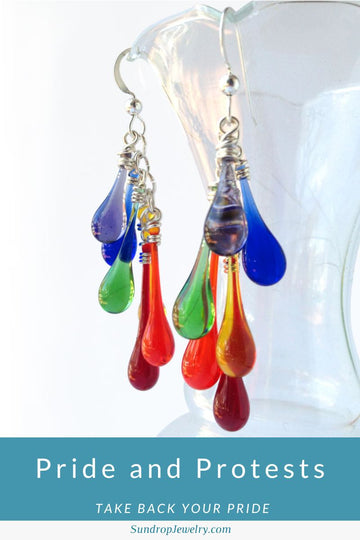
Last week I talked about the impact of the glass industry in general. Today I'm going to get a little more specific.
Bullseye Glass
Some of our glass comes from recycled bottles, but most of it comes from the Bullseye Glass Company in Portland, Oregon.
The chemicals to color the glass come from all over the world, but most of the bulk raw materials (sand), come from relatively nearby in the northwest U.S. - minimizing shipping.
And in the past few years they've put in a couple new systems designed to reduce the impact of glass manufacturing. The first is a liquid oxygen system. Natural gas is burned to produce heat to melt glass. In order to burn, the hydrocarbons of the gas are reacting with the oxygen in the air. But oxygen is only about 21% of air, so a lot of what gets heated and reacted is nitrogen. By using pure oxygen instead of ambient air, much less natural gas is needed, and much less nitrous oxide pollution is produced. According to Bullseye, this system "will eventually reduce our carbon emissions by as much as 40%, and our nitrous oxide emissions by more than 90%."
The next cool thing is the cooling system. In 2004 they switched to a recycling water cooling system, cutting their water use by more than half.
Other enviro-friendly things they do are encouraging employees not to commute by car, and internal recycling (using the ends of glass sheets to make things that are supposed to be in small pieces, like frit, and lumping broken bits together to make black glass).
So, although we've been using Bullseye for the colors and quality of glass, it seems like they're a pretty good choice from an environmental standpoint too.
How does this add up for Sundrops?
To figure the impact of the glass we start out with, we took the carbon footprint of glass production, and combined it with the costs of shipping the raw materials and finished glass. Bullseye provided us with precise numbers for their glass production. I can't publish them here because they're a trade secret, but have used them in my own calculations.Shipping Footprint
The best info I was able to find actually came from a study on the impacts of food transportation in Iowa from the Leopold Center for Sustainable AgricultureThey broke up transport into big, small, and medium trucks, and looked at how much they carried and what their fuel mileage was. It ends up being more efficient to carry stuff in big trucks.

in different trucks.
The ever helpful Energy Information Administration has a page giving the CO2 emissions for different fuel types
Carbon Footprint of Glass
Plugging in the different kinds of fuel (natrual gas to melt glass, diesel to move it around), and the distances, I get a carbon footprint of 4 pounds CO2 per pound of glass. This is the impact of the glass when I pick it up from the store (I walk to and from the stained glass store, so I'm not counting any extra transport cost there), before we melt it into earrings.Sundrop Jewelry's footprint comes from glass, silver, plastic, paper, manufacturing, and sales. I've got the number for glass. What will the rest be? Where's the easiest place to cut the impact?
Related Articles





